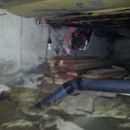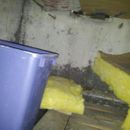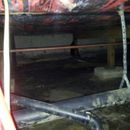Using EPS and XPS in a conditioned crawl space
I live in Juneau Alaska, Climate Zone 7.
Living here, I often have to use whatever is available rather than the optimum. We just don’t have access and supply to everything. This being said, I am looking to insulate my crawlspace and convert it into a conditioned crawlspace by insulating the interior stem walls to the footings. In accordance with 2012 standards, I want to be sure that I have AT LEAST R-15 on the stem walls and joist bays.
Herein lies the problem.
The local hardware stores only have 43 units of EPS and 63 units of XPS in 2″x2’x8′ lengths. My access necessitates this size to maximize factory edge precision. The problem is that I need 90 sheets (including waste calculations). Therefore, I will need to utilize one layer of each material to achieve my desired results or wait until the next barge comes in (could be a year from now).
My quandary lies in the research. My understanding is that EPS increases in insulating performance in cold climates while XPS degrades in cold climates. On the flip side, XPS has better water resistance. So, what layer do I attach to the stem wall? It would seem that the XPS would perform better against water penetration against the stem wall, but would degrade in R-value against the cold wall. However, EPS against the wall would potentially perform better in our cold climate against the stem wall, but I sacrifice water penetration optimums.
Since my STEM wall does not show regular water penetrations, I am leaning towards installing the EPS against the cold surface and installing the XPS on the interior, warmer side. This would (apparently) maximize the insulating properties. ANd yes, I will stagger and tape/caulk/foam all seams as appropriate in each area.
Before I start, I would like some feedback regarding my quandary. What say you all? Pictures attached. And yes, my crawlspace will be emptied of all material and the bat insulation in the floor cavities will be removed prior to sealing and insulating the stem wall. 🙂
GBA Detail Library
A collection of one thousand construction details organized by climate and house part












Replies
Addendum:
To clarify, the question is simply: When using one layer of EPS and one layer of XPS to insulate a stem wall in Climate 7 (Juneau Alaska), which layer should be attached to the stem wall (the cold and potentially wet surface) and which layer should be installed against the first layer inside the crawlspace (the warm side)?
Emil,
I don't think it matters which layer you install first.
For more information on insulating crawl space walls, see Building an Unvented Crawl Space.
Thanks Dan. FYI, they got a shipment of extra XPS today and will be providing it for a discount since my EPS order did not arrive when I needed. I will be installing 4" into the crawlspace now.
FYI, I spoke with our Cold Climate Housing instructor at the University of Alaska Southeast and he recommended XPS against the stem wall instead of EPS. This has to do with moisture since we live in a temperate rain forest. This is probably case specific in my case, but I wanted to share.
I can see the moisture potential from your pics. definitely two sheets XPS.....there is no need to 'dry towards the interior'. In my basement I sealed the sheets all over except at the bottom, so that liquid can escape if need be. after several years I can be certain the installation was a fantastic idea. basement is now warmer than main floor
Thanks Don. The local Home Depot honored the order of EPS by giving me XPS at their cost. The result is that I got the XPS for a little cheaper than the $/r-value ratio for EPS. A win-win for both of us.
The pics are a bit deceiving. There is not a systemic issue with water in the crawl. However, there was flooding in the crawl 2 years ago when we had 20+ days of constant rain, Since then, the city improved the drainage, but that flood left an inch or so of standing water in the crawl for a couple of weeks and wet soil for a few months as everything dried, That also basically destroyed the vapor barrier you see in the pics. Today, the dirt is actually very dry but covers the vapor barrier. Also, my flash sucks and it looks much darker than it really is.
Since this Q&A is read by other people, I will post pics after we install everything this weekend so there are before and after photos. I will be replacing the existing damaged clear plastic vapor barrier with a new product by husky called "Yellowguard". I think the XPS on the walls and the yellowguard vapor barrier will make a world of difference in the photos.
Both XPS and EPS rise in R-value with falling temperatures, but with slightly different up-rating curves. Somewhere around -10F average temp through the foam (something you'll never see in fairly temperate Juneau, but might in Fairbanks with a 40F crawlspace) they're pretty much identical in R-value at a given thickness.
In 50- years after most of the blowing agent has escaped the XPS, the difference in R/inch at 75F average temp (the labeled R-value) is pretty negligible too. Both are pretty good at protecting against ground moisture- even Type-II EPS is a class-II vapor retarder @ 4".
XPS is more likely than EPS to become waterlogged over time in VERY wet conditions (which is why EPS and not XPS is used for marine flotation applications.) When submerged EPS maxes out pretty quickly (a few weeks) at about 6-7% water, but that water is in primarily in the interstitial spaces between beads, not inside the closed cells, and the insulation properties are still pretty good, at about 90% the R-value of it's dry performance. Initial absorption of water into XPS takes place more slowly, but it also takes forever to dry, and takes a comparable hit at any saturation level. The fact that it releases the water quickly means putting the EPS against the foundation is the "better" stackup. Almost all insulated concrete forms are made of Type-II EPS, in direct contact with concrete, in many cases concrete saturated with moisture wicking up from the footings.
So, you went all XPS, not a disaster, but if you have a bulk-wetting/weeping issues on the concrete, at least use a concrete sealer on it to slow the capillary wicking down before putting up the insulation. In the pics it looks like most of the damp is at the bottom, where it's wicking up moisture from the footing. It may be worth digging-in an interior-side perimeter drain to a sump and backfilling with clean screenings before laying down your new vapor barrier.
Thanks Dana.
I was worried about possible water-logging as well. To overcome this, I was planning to actually run the vapor barrier behind the XPS when I attach the XPS to the wall. This will be a continuous run down to the ground from the joist bay. Does that sound wise or do you suggest an alternative. I could water seal the concrete, but the barrier I am using is the 10 mil (polyolefin Husky Yellow Guard (http://www.yellowguard.com/) with .1 perm. Do you think this is wise or unwise? What alternatives should be considered?
As long as you have a pretty good sill gasket between the top of the foundation and the sill as a capillary break running the vapor barrier all the way up is fine. In really wet foundations a dimple-board vapor barrier against the wall would be preferable to 10 mil poly or EPDM sheeting, but there's nothing visible in those pics that would make that seem necessary.
If you DON'T have a sill gasket you could be pushing your luck by blocking the drying toward the interior. With the vapor barrier on the inside all of that wicking currently drying into the crawlspace near the floor will end up drying to the above-grade exterior, which isn't exactly a reliable drying direction in foggy-dew rainy Juneau. With 2' overhangs on the eaves & rake of the roof and 18" of above grade exposure it could conceivably still be dry enough to skate without a capillary break between the concrete and sill, but with low exposure and narrower overhangs, maybe not.
You'll likely get some seasonal periodic frost formation between the top of the foam and the poly vapor barrier but if the foam is air tight it won't be enough to matter. Even in January it gets above freezing at least for a few hours most days, so a thick seasonal buildup of frost simply won't be happening the way it might in colder AK locations.
Ok. One more question for the wise sages of this board. If you look at the attached image, you will see some support bolts/rebar sticking out about a foot past the stem wall. I lean towards cutting these off as close to the stem wall as possible to protect the seal between the vapor barrier and wall. It will also be easier to keep the XPS flush against the wall and eliminate the need to penetrate the barriers. Is there a downside to cutting off this rebar of which I am unaware? Am I wasting my time and just need to poike the rebar through and then caulk and foam the penetrations. I am leaning heavily towards cutting off the rebar.
Cut the rebar- the high thermal conductivity of steel is reason enough!
Thanks Dana. I was thinking the same thing but was seeking counter perspectives to be safe. Your agreement is appreciated and I will start clipping those early Saturday Morning.
Finished.
The store ran out of EPS, but sold me XPS for the same price.Pics are below. What do you think? I am planning to add 2 more feet of vapor barrier on the stem wall.
Nice.
By the way, that "rebar" is/are actually snapties.
Good looking crawl space.